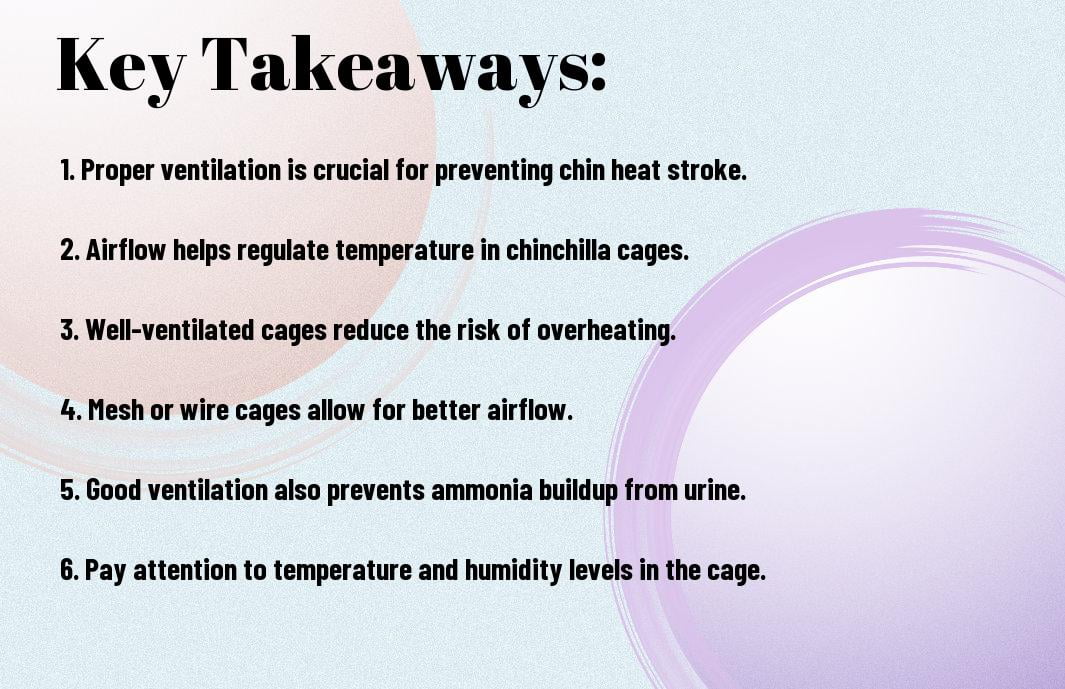Is A Well-ventilated Cage The Key To Preventing Chin Heat Stroke?
Are you aware that chinchillas are highly susceptible to heat stroke? If you’re a chin parent, you know how important it is to keep your furry friend safe and comfortable. One of the key factors in preventing heat stroke in chinchillas is ensuring that they have a well-ventilated cage. In this blog post, we will discuss the importance of proper ventilation in your chinchilla’s cage and how it can help prevent the potentially deadly effects of heat stroke. You’ll also learn about some other important tips for keeping your chinchilla cool and comfortable in hot weather.
We are supported by our audience. When you purchase through links on our site, we may earn an affiliate commission, at no extra cost for you. Learn more. Last update on 26th July 2024 / Images from Amazon Product Advertising API.

The Role of the Cage in Chin’s Health
The cage plays a crucial role in the overall health and well-being of your chinchilla. It not only provides a safe and secure environment for your pet but also plays a significant role in regulating their body temperature and preventing heat-related illnesses.
The Science Behind Chin Heat Stroke
Chinchillas are highly susceptible to heat stroke due to their thick fur, which inhibits their ability to regulate body temperature. When exposed to high temperatures, chinchillas can quickly become overheated, leading to heat stroke. This can be extremely dangerous and even life-threatening for your chinchilla if not addressed promptly.
Relevance of Cage Ventilation
Proper cage ventilation is essential in preventing heat stroke in chinchillas. Adequate airflow helps to dissipate excess heat and maintain a comfortable temperature within the cage. Without proper ventilation, the air inside the cage can become stagnant, leading to a buildup of heat and humidity. This can significantly increase the risk of your chinchilla suffering from heat stroke.
It is important to ensure that your chinchilla’s cage is well-ventilated to prevent heat-related illness. Poor ventilation can lead to a buildup of heat and humidity, creating a potentially dangerous environment for your pet. By providing adequate airflow within the cage, you can help mitigate the risk of heat stroke and ensure the overall health and well-being of your chinchilla.
Comparing Ventilated and Non-Ventilated Cages
While keeping your chinchilla in a cage with poor ventilation, you may inadvertently be putting your pet at risk of heat stroke. According to the American Kennel Club, heat stroke can occur in dogs at temperatures as low as 105 degrees Fahrenheit, and it’s likely that chinchillas are equally susceptible to overheating. You can read more about the dangers of heat stroke in animals in this article titled ‘How Hot Is Too Hot? Heatstroke in Dogs’.
| Ventilated Cages | Non-Ventilated Cages |
| Proper airflow to regulate temperature | Poor air circulation leading to higher temperatures |
| Reduced risk of heat stroke | Increased risk of heat stroke |
The Effects of Poorly Ventilated Cages on Chins
If your chinchilla is kept in a poorly ventilated cage, the risk of heat stroke is significantly higher. Without proper air circulation, the temperature inside the cage can quickly rise to dangerous levels, potentially leading to dehydration, lethargy, and even death. It’s crucial to ensure that your chinchilla’s living space provides adequate ventilation to prevent these serious consequences.
Advantages of Well-Ventilated Cages
On the other hand, a well-ventilated cage can help regulate your chinchilla’s body temperature more effectively, reducing the risk of heat stroke. Proper airflow ensures that your pet can stay cool and comfortable, even during the warmer months. It’s essential to prioritize ventilation when selecting a cage for your chinchilla to ensure their well-being and longevity.
Steps to Ensure a Well-Ventilated Cage
After learning more about the potential health risks for your chinchilla, such as the possibility of heat stroke, it’s crucial to take steps to ensure their living environment is well-ventilated to minimize this risk. According to Chinchillas – Heath Conditions | VCA Animal Hospitals, proper ventilation is key to preventing heat stroke in chinchillas.
Tips for Choosing a Ventilated Cage
When selecting a cage for your chinchilla, it’s important to prioritize proper ventilation. Look for cages with metal wire construction and spacious designs to allow for optimal air flow. The cage should also have a solid base to help contain the bedding and droppings. Additionally, ensure that the cage has multiple levels or platforms to allow your pet to move around and regulate their body temperature. Recognizing the importance of a well-designed and ventilated cage is crucial for your chinchilla’s overall well-being.
Maintaining Proper Cage Ventilation
Once you have chosen an appropriate cage for your chinchilla, it’s important to maintain proper ventilation on a regular basis. This includes cleaning the cage regularly to prevent the build-up of dust and debris that can obstruct air flow. You should also place the cage in a well-ventilated area of your home while ensuring it is not in direct sunlight or close to heating vents. By maintaining adequate ventilation, you can help prevent the risk of heat stroke and other health issues in your chinchilla.
Is A Well-ventilated Cage The Key To Preventing Chin Heat Stroke?
Following this examination of the impact of ventilation on preventing chin heat stroke, it is clear that a well-ventilated cage is indeed the key to ensuring the health and safety of your pet. The proper airflow within their living space is crucial in regulating their body temperature and preventing heat-related illnesses. By ensuring that your pet’s cage has adequate ventilation, you can significantly reduce the risk of heat stroke and create a comfortable environment for your furry friend.